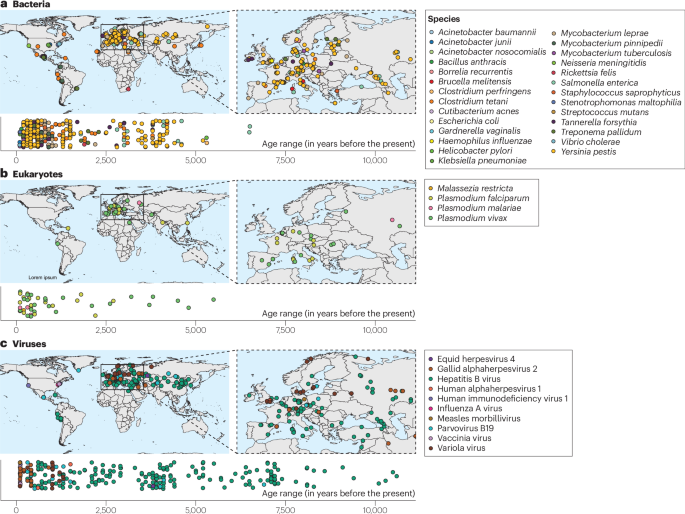Vos, T. et al. Global burden of 369 diseases and injuries in 204 countries and territories, 1990–2019: a systematic analysis for the Global Burden of Disease Study 2019. Lancet 396, 1204–1222 (2020).
Spigelman, M. & Lemma, E. The use of the polymerase chain reaction (PCR) to detect Mycobacterium tuberculosis in ancient skeletons. Int. J. Osteoarchaeol. 3, 137–143 (1993).
Salo, W. L., Aufderheide, A. C., Buikstra, J. & Holcomb, T. A. Identification of Mycobacterium tuberculosis DNA in a pre-Columbian Peruvian mummy. Proc. Natl Acad. Sci. USA 91, 2091–2094 (1994).
Arriaza, B. T., Salo, W., Aufderheide, A. C. & Holcomb, T. A. Pre-Columbian tuberculosis in northern Chile: molecular and skeletal evidence. Am. J. Phys. Anthropol. 98, 37–45 (1995).
Drancourt, M., Aboudharam, G., Signoli, M., Dutour, O. & Raoult, D. Detection of 400-year-old Yersinia pestis DNA in human dental pulp: an approach to the diagnosis of ancient septicemia. Proc. Natl Acad. Sci. USA 95, 12637–12640 (1998).
Zink, A., Haas, C., Reishl, U., Szeimies, U. & Nerlich, A. G. Molecular analysis of skeletal tuberculosis in an ancient Egyptian population. J. Med. Microbiol. 50, 355–366 (2001).
Orlando, L. et al. Ancient DNA analysis. Nat. Rev. Methods Primers 1, 15 (2021).
Spyrou, M. A., Bos, K. I., Herbig, A. & Krause, J. Ancient pathogen genomics as an emerging tool for infectious disease research. Nat. Rev. Genet. 20, 323–340 (2019).
Bos, K. I. et al. Paleomicrobiology: diagnosis and evolution of ancient pathogens. Annu. Rev. Microbiol. 73, 639–666 (2019).
Duchêne, S., Ho, S. Y. W., Carmichael, A. G., Holmes, E. C. & Poinar, H. The recovery, interpretation and use of ancient pathogen genomes. Curr. Biol. 30, R1215–R1231 (2020).
Kahle, D. & Wickham, H. ggmap: spatial visualization with ggplot2. R J. 5, 144–161 (2013).
Bos, K. I. et al. A draft genome of Yersinia pestis from victims of the Black Death. Nature 478, 506–510 (2011).
Lewis, C. M., Akinyi, M. Y., DeWitte, S. N. & Stone, A. C. Ancient pathogens provide a window into health and well-being. Proc. Natl Acad. Sci. USA 120, e2209476119 (2023).
Harper, K. Plagues upon the Earth: Disease and the Course of Human History (Princeton Univ. Press, 2021).
Bryce, T. The Kingdom of the Hittites (Oxford Univ. Press, 2005).
Haensch, S. et al. Distinct clones of Yersinia pestis caused the Black Death. PLoS Pathog. 6, e1001134 (2010).
Fellows Yates, J. A. et al. Community-curated and standardised metadata of published ancient metagenomic samples with AncientMetagenomeDir. Sci. Data 8, 31 (2021).
Spyrou, M. A. et al. The source of the Black Death in fourteenth-century central Eurasia. Nature 606, 718–724 (2022).
Guellil, M. et al. A genomic and historical synthesis of plague in 18th century Eurasia. Proc. Natl Acad. Sci. USA 117, 28328–28335 (2020).
Spyrou, M. A. et al. Phylogeography of the second plague pandemic revealed through analysis of historical Yersinia pestis genomes. Nat. Commun. 10, 4470 (2019).
Bos, K. I. et al. Eighteenth century Yersinia pestis genomes reveal the long-term persistence of an historical plague focus. eLife 5, e12994 (2016).
Keller, M. et al. Ancient Yersinia pestis genomes from across western Europe reveal early diversification during the First Pandemic (541–750). Proc. Natl Acad. Sci. USA 116, 12363–12372 (2019).
Wagner, D. M. et al. Yersinia pestis and the Plague of Justinian 541–543 AD: a genomic analysis. Lancet Infect. Dis. 14, 319–326 (2014).
Damgaard, P. d. B. et al. 137 ancient human genomes from across the Eurasian steppes. Nature 557, 369–374 (2018).
Keller, M. et al. A refined phylochronology of the Second Plague Pandemic in western Eurasia. Preprint at bioRxiv https://doi.org/10.1101/2023.07.18.549544 (2023).
Vågene, ÅJ. et al. Salmonella enterica genomes from victims of a major sixteenth-century epidemic in Mexico. Nat. Ecol. Evol. 2, 520–528 (2018).
Zhou, Z. et al. Pan-genome analysis of ancient and modern Salmonella enterica demonstrates genomic stability of the invasive Para C lineage for millennia. Curr. Biol. 28, 2420–2428.e10 (2018).
Haller, M. et al. Mass burial genomics reveals outbreak of enteric paratyphoid fever in the late medieval trade city Lübeck. iScience 24, 102419 (2021).
Majander, K. et al. Ancient bacterial genomes reveal a high diversity of Treponema pallidum strains in early modern Europe. Curr. Biol. 30, 3788–3803.e10 (2020).
Giffin, K. et al. A treponemal genome from an historic plague victim supports a recent emergence of yaws and its presence in 15th century Europe. Sci. Rep. 10, 9499 (2020).
Barquera, R. et al. Ancient genomes reveal a deep history of treponemal disease in the Americas. Nature https://doi.org/10.1038/s41586-024-08515-5 (2024).
Pfrengle, S. et al. Mycobacterium leprae diversity and population dynamics in medieval Europe from novel ancient genomes. BMC Biol. 19, 220 (2021).
Schuenemann, V. J. et al. Ancient genomes reveal a high diversity of Mycobacterium leprae in medieval Europe. PLoS Pathog. 14, e1006997 (2018).
Sabin, S. et al. A seventeenth-century Mycobacterium tuberculosis genome supports a neolithic emergence of the Mycobacterium tuberculosis complex. Genome Biol. 21, 201 (2020).
Urban, C. et al. Ancient Mycobacterium leprae genome reveals medieval English red squirrels as animal leprosy host. Curr. Biol. 34, 2221–2230 (2024).
Hopkins, D. R. & Lythcott, G. I. Princes and Peasants: Smallpox in History (Univ. Chicago Press, 1983).
Mühlemann, B. et al. Diverse variola virus (smallpox) strains were widespread in northern Europe in the Viking Age. Science 369, eaaw8977 (2020).
Duggan, A. T. et al. 17th century variola virus reveals the recent history of smallpox. Curr. Biol. 26, 3407–3412 (2016).
Patrono, L. V. et al. Archival influenza virus genomes from Europe reveal genomic variability during the 1918 pandemic. Nat. Commun. 13, 2314 (2022).
Worobey, M. et al. 1970s and ‘patient 0’ HIV-1 genomes illuminate early HIV/AIDS history in North America. Nature 539, 98–101 (2016).
Newfield, T. P. & Labuhn, I. Realizing consilience in studies of pre-instrumental climate and pre-laboratory disease. J. Interdisc. Hist. 48, 211–240 (2017).
Eaton, K. et al. Plagued by a cryptic clock: insight and issues from the global phylogeny of Yersinia pestis. Commun. Biol. 6, 23 (2023).
Green, M. H. The four black deaths. Am. Hist. Rev. 125, 1601–1631 (2020).
Zuckerkandl, E. & Pauling, L. in Horizons in Biochemistry (eds Kasha, M. & Pullman, B.) 189–225 (Academic, 1962).
Ho, S. Y. W. & Duchêne, S. Molecular-clock methods for estimating evolutionary rates and timescales. Mol. Ecol. 23, 5947–5965 (2014).
Ho, S. Y. W. & Duchêne, S. Dating the emergence of human pathogens. Science 368, 1310–1311 (2020).
Drummond, A. J., Pybus, O. G., Rambaut, A., Forsberg, R. & Rodrigo, A. G. Measurably evolving populations. Trends Ecol. Evol. 18, 481–488 (2003).
Rambaut, A., Lam, T. T., Max Carvalho, L. & Pybus, O. G. Exploring the temporal structure of heterochronous sequences using TempEst (formerly Path-O-Gen). Virus Evol. 2, vew007 (2016).
Duchene, S. et al. Bayesian evaluation of temporal signal in measurably evolving populations. Mol. Biol. Evol. 37, 3363–3379 (2020).
Yuen, L. K. W. et al. Tracing ancient human migrations into Sahul using hepatitis B virus genomes. Mol. Biol. Evol. 36, 942–954 (2019).
Paraskevis, D. et al. Dating the origin and dispersal of hepatitis B virus infection in humans and primates. Hepatology 57, 908–916 (2013).
Kolb, A. W., Ané, C. & Brandt, C. R. Using HSV-1 genome phylogenetics to track past human migrations. PLoS ONE 8, e76267 (2013).
Comas, I. et al. Out-of-Africa migration and Neolithic coexpansion of Mycobacterium tuberculosis with modern humans. Nat. Genet. 45, 1176–1182 (2013).
Sun, B. et al. Origin and dispersal history of hepatitis B virus in eastern Eurasia. Nat. Commun. 15, 2951 (2024).
Guellil, M. et al. Ancient herpes simplex 1 genomes reveal recent viral structure in Eurasia. Sci. Adv. 8, eabo4435 (2022).
Aiewsakun, P. & Katzourakis, A. Time-dependent rate phenomenon in viruses. J. Virol. 90, 7184–7195 (2016).
Duchêne, S. et al. Genome-scale rates of evolutionary change in bacteria. Microb. Genom. 2, e000094 (2016).
Zhou, Y. & Holmes, E. C. Bayesian estimates of the evolutionary rate and age of hepatitis B virus. J. Mol. Evol. 65, 197–205 (2007).
Mühlemann, B. et al. Ancient human parvovirus B19 in Eurasia reveals its long-term association with humans. Proc. Natl Acad. Sci. USA 115, 7557–7562 (2018).
Parsyan, A., Szmaragd, C., Allain, J.-P. & Candotti, D. Identification and genetic diversity of two human parvovirus B19 genotype 3 subtypes. J. Gen. Virol. 88, 428–431 (2007).
Norja, P., Eis-Hübinger, A. M., Söderlund-Venermo, M., Hedman, K. & Simmonds, P. Rapid sequence change and geographical spread of human parvovirus B19: comparison of B19 virus evolution in acute and persistent infections. J. Virol. 82, 6427–6433 (2008).
Firth, C. et al. Using time-structured data to estimate evolutionary rates of double-stranded DNA viruses. Mol. Biol. Evol. 27, 2038–2051 (2010).
Düx, A. et al. Measles virus and rinderpest virus divergence dated to the sixth century BCE. Science 368, 1367–1370 (2020).
Wertheim, J. O. & Kosakovsky Pond, S. L. Purifying selection can obscure the ancient age of viral lineages. Mol. Biol. Evol. 28, 3355–3365 (2011).
Kimura, H. et al. Molecular evolution of haemagglutinin (H) gene in measles virus. Sci. Rep. 5, 11648 (2015).
Andrades Valtueña, A. et al. Stone Age Yersinia pestis genomes shed light on the early evolution, diversity, and ecology of plague. Proc. Natl Acad. Sci. USA 119, e2116722119 (2022).
Andrades Valtueña, A. et al. The Stone Age plague and its persistence in Eurasia. Curr. Biol. 27, 3683–3691.e8 (2017).
Harper, K. & Armelagos, G. The changing disease-scape in the third epidemiological transition. Int. J. Environ. Res. Public Health 7, 675–697 (2010).
Long, G. S. et al. A 14th century CE Brucella melitensis genome and the recent expansion of the Western Mediterranean clade. PLoS Pathog. 19, e1011538 (2023).
L’Hôte, L. et al. An 8000 years old genome reveals the Neolithic origin of the zoonosis Brucella melitensis. Nat. Commun. 15, 6132 (2024).
Wolfe, N. D., Dunavan, C. P. & Diamond, J. Origins of major human infectious diseases. Nature 447, 279–283 (2007).
Diamond, J. Evolution, consequences and future of plant and animal domestication. Nature 418, 700–707 (2002).
Harper, K. N., Zuckerman, M. K., Turner, B. L. & Armelagos, G. J. Primates, pathogens, and evolution: a context for understanding emerging disease. Primates Pathog. Evol. https://doi.org/10.1007/978-1-4614-7181-3_13 (2013).
Tallavaara, M., Luoto, M., Korhonen, N., Järvinen, H. & Seppä, H. Human population dynamics in Europe over the Last Glacial Maximum. Proc. Natl Acad. Sci. USA 112, 8232–8237 (2015).
Membrebe, J. V., Suchard, M. A., Rambaut, A., Baele, G. & Lemey, P. Bayesian inference of evolutionary histories under time-dependent substitution rates. Mol. Biol. Evol. 36, 1793–1803 (2019).
Ghafari, M., Simmonds, P., Pybus, O. G. & Katzourakis, A. A mechanistic evolutionary model explains the time-dependent pattern of substitution rates in viruses. Curr. Biol. 31, 4689–4696.e5 (2021).
Kocher, A. et al. Ten millennia of hepatitis B virus evolution. Science 374, 182–188 (2021).
Bos, K. I. et al. Pre-Columbian mycobacterial genomes reveal seals as a source of New World human tuberculosis. Nature 514, 494–497 (2014).
Light-Maka, I. et al. Bronze Age Yersinia pestis genome from sheep sheds light on hosts and evolution of a prehistoric plague lineage. Cell 188, 5748–5762 (2025).
Spyrou, M. A. et al. Historical Yersinia pestis genomes reveal the European Black Death as the source of ancient and modern plague pandemics. Cell Host Microbe 19, 874–881 (2016).
Eaton, K. et al. Emergence, continuity, and evolution of Yersinia pestis throughout medieval and early modern Denmark. Curr. Biol. CB 33, 1147–1152.e5 (2023).
Morozova, I. et al. New ancient eastern European Yersinia pestis genomes illuminate the dispersal of plague in Europe. Philos. Trans. R. Soc. B Biol. Sci. 375, 20190569 (2020).
Schmid, B. V. et al. Climate-driven introduction of the Black Death and successive plague reintroductions into Europe. Proc. Natl Acad. Sci. USA 112, 3020–3025 (2015).
Stenseth, N. Chr. et al. No evidence for persistent natural plague reservoirs in historical and modern Europe. Proc. Natl Acad. Sci. USA 119, e2209816119 (2022).
Bramanti, B., Wu, Y., Yang, R., Cui, Y. & Stenseth, N. Chr. Assessing the origins of the European plagues following the Black Death: a synthesis of genomic, historical, and ecological information. Proc. Natl Acad. Sci. USA 118, e2101940118 (2021).
Pollitzer, R. Plague studies. Bull. World Health Organ. 4, 475–533 (1951).
Stenseth, N. Chr., Dean, K. R. & Bramanti, B. The end of plague in Europe. Centaurus 64, 61–72 (2022).
Gaul, E. & Spyrou, M. A. Historical plague pandemics: perspectives from ancient DNA. Trends Microbiol. 33, 7–10 (2024).
Rascovan, N. et al. Emergence and spread of basal lineages of Yersinia pestis during the Neolithic decline. Cell 176, 295–305.e10 (2019).
Susat, J. et al. A 5,000-year-old hunter-gatherer already plagued by Yersinia pestis. Cell Rep. 35, 109278 (2021).
Seersholm, F. V. et al. Repeated plague infections across six generations of Neolithic farmers. Nature 632, 114–121 (2024).
Macleod, R. et al. Lethal plague outbreaks in Lake Baikal hunter–gatherers 5500 years ago. Preprint at bioRxiv https://doi.org/10.1101/2024.11.13.623490 (2024).
Michel, M. et al. Ancient plasmodium genomes shed light on the history of human malaria. Nature 631, 125–133 (2024).
de-Dios, T. et al. Genetic affinities of an eradicated European Plasmodium falciparum strain. Microb. Genom. 5, e000289 (2019).
Mühlemann, B. et al. Ancient hepatitis B viruses from the Bronze Age to the medieval period. Nature 557, 418–423 (2018).
Pugach, I., Delfin, F., Gunnarsdottir, E., Kayser, M. & Stoneking, M. Genome-wide data substantiate Holocene gene flow from India to Australia. Proc. Natl Acad. Sci. USA 110, 1803–1808 (2013).
Borry, M., Hübner, A., Rohrlach, A. B. & Warinner, C. PyDamage: automated ancient damage identification and estimation for contigs in ancient DNA de novo assembly. PeerJ 9, e11845 (2021).
Key, F. M. et al. Emergence of human-adapted Salmonella enterica is linked to the Neolithization process. Nat. Ecol. Evol. 4, 324–333 (2020).
Swali, P. et al. Yersinia pestis genomes reveal plague in Britain 4000 years ago. Nat. Commun. 14, 2930 (2023).
Rasmussen, S. et al. Early divergent strains of Yersinia pestis in Eurasia 5,000 years ago. Cell 163, 571–582 (2015).
Volz, E. M., Koelle, K. & Bedford, T. Viral phylodynamics. PLoS Comput. Biol. 9, e1002947 (2013).
Bland, D. M., Miarinjara, A., Bosio, C. F., Calarco, J. & Hinnebusch, B. J. Acquisition of Yersinia murine toxin enabled Yersinia pestis to expand the range of mammalian hosts that sustain flea-borne plague. PLoS Pathog. 17, e1009995 (2021).
Susat, J. et al. Neolithic Yersinia pestis infections in humans and a dog. Commun. Biol. 7, 1013 (2024).
Susat, J. et al. Yersinia pestis strains from Latvia show depletion of the pla virulence gene at the end of the second plague pandemic. Sci. Rep. 10, 14628 (2020).
Sidhu, R. K. et al. Attenuation of virulence in Yersinia pestis across three plague pandemics. Science 388, eadt3880 (2025).
Cui, Y. et al. Historical variations in mutation rate in an epidemic pathogen, Yersinia pestis. Proc. Natl Acad. Sci. USA 110, 577–582 (2013).
Guellil, M. et al. Genomic blueprint of a relapsing fever pathogen in 15th century Scandinavia. Proc. Natl Acad. Sci. USA 115, 10422–10427 (2018).
Swali, P. et al. Ancient Borrelia genomes document the evolutionary history of louse-borne relapsing fever. Science 388, eadr2147 (2025).
Bonczarowska, J. H. et al. Pathogen genomics study of an early medieval community in Germany reveals extensive co-infections. Genome Biol. 23, 250 (2022).
Fiddaman, S. R. et al. Ancient chicken remains reveal the origins of virulence in Marek’s disease virus. Science 382, 1276–1281 (2023).
Wolf, J. M., Carli, S. D., Pereira, V. R. Z. B., Simon, D. & Lunge, V. R. Temporal evolution and global spread of hepatitis B virus genotype G. J. Viral Hepat. 28, 393–399 (2021).
Li, K. et al. Critical role of the 36-nucleotide insertion in hepatitis B virus genotype G in core protein expression, genome replication, and virion secretion. J. Virol. 81, 9202–9215 (2007).
Dimopoulos, E. A. et al. HAYSTAC: a Bayesian framework for robust and rapid species identification in high-throughput sequencing data. PLoS Comput. Biol. 18, e1010493 (2022).
Hübler, R. et al. HOPS: automated detection and authentication of pathogen DNA in archaeological remains. Genome Biol. 20, 280 (2019).
Pochon, Z. et al. aMeta: an accurate and memory-efficient ancient metagenomic profiling workflow. Genome Biol. 24, 242 (2023).
Sikora, M. et al. The spatiotemporal distribution of human pathogens in ancient Eurasia. Nature https://doi.org/10.1038/s41586-025-09192-8 (2025).
Featherstone, L. A., Zhang, J. M., Vaughan, T. G. & Duchene, S. Epidemiological inference from pathogen genomes: a review of phylodynamic models and applications. Virus Evol. 8, veac045 (2022).
Drummond, A. J., Rambaut, A., Shapiro, B. & Pybus, O. G. Bayesian coalescent inference of past population dynamics from molecular sequences. Mol. Biol. Evol. 22, 1185–1192 (2005).
Stadler, T., Kühnert, D., Bonhoeffer, S. & Drummond, A. J. Birth–death skyline plot reveals temporal changes of epidemic spread in HIV and hepatitis C virus (HCV). Proc. Natl Acad. Sci. USA 110, 228–233 (2013).
Lemey, P., Rambaut, A., Drummond, A. J. & Suchard, M. A. Bayesian phylogeography finds its roots. PLoS Comput. Biol. 5, e1000520 (2009).
Lemey, P., Rambaut, A., Welch, J. J. & Suchard, M. A. Phylogeography takes a relaxed random walk in continuous space and time. Mol. Biol. Evol. 27, 1877–1885 (2010).
Kühnert, D., Stadler, T., Vaughan, T. G. & Drummond, A. J. Phylodynamics with migration: a computational framework to quantify population structure from genomic data. Mol. Biol. Evol. 33, 2102–2116 (2016).
Müller, N. F., Rasmussen, D. & Stadler, T. MASCOT: parameter and state inference under the marginal structured coalescent approximation. Bioinformatics 34, 3843–3848 (2018).
Urban, C. et al. An ancient influenza genome from Switzerland allows deeper insights into host adaptation during the 1918 flu pandemic in Europe. BMC Biol. 23, 179 (2025).
Ramirez, D. A., Saka, H. A. & Nores, R. Detection of Vibrio cholerae aDNA in human burials from the fifth cholera pandemic in Argentina (1886–1887 AD). Int. J. Paleopathol. 32, 74–79 (2021).
Lebrasseur, O., More, K. D. & Orlando, L. Equine herpesvirus 4 infected domestic horses associated with Sintashta spoke-wheeled chariots around 4,000 years ago. Virus Evol. 10, vead087 (2024).
Schuenemann, V. J. et al. Genome-wide comparison of medieval and modern Mycobacterium leprae. Science 341, 179–183 (2013).
Parker, C. et al. A systematic investigation of human DNA preservation in medieval skeletons. Sci. Rep. 10, 18225 (2020).
Margaryan, A. et al. Ancient pathogen DNA in human teeth and petrous bones. Ecol. Evol. 8, 3534–3542 (2018).
Maixner, F. et al. The 5300-year-old Helicobacter pylori genome of the Iceman. Science 351, 162–165 (2016).
Devault, A. M. et al. Second-Pandemic strain of Vibrio cholerae from the Philadelphia cholera outbreak of 1849. N. Engl. J. Med. 370, 334–340 (2014).
Long, G. S. et al. A 16th century Escherichia coli draft genome associated with an opportunistic bile infection. Commun. Biol. 5, 599 (2022).
Devault, A. M. et al. A molecular portrait of maternal sepsis from Byzantine Troy. eLife 6, e20983 (2017).
Dabney, J. et al. Complete mitochondrial genome sequence of a Middle Pleistocene cave bear reconstructed from ultrashort DNA fragments. Proc. Natl Acad. Sci. USA 110, 15758–15763 (2013).
Rohland, N., Glocke, I., Aximu-Petri, A. & Meyer, M. Extraction of highly degraded DNA from ancient bones, teeth and sediments for high-throughput sequencing. Nat. Protoc. 13, 2447–2461 (2018).
Gamba, C. et al. Comparing the performance of three ancient DNA extraction methods for high-throughput sequencing. Mol. Ecol. Resour. 16, 459–469 (2016).
Meyer, M. & Kircher, M. Illumina sequencing library preparation for highly multiplexed target capture and sequencing. Cold Spring Harb. Protoc. 2010, pdb.prot5448 (2010).
Gansauge, M.-T., Aximu-Petri, A., Nagel, S. & Meyer, M. Manual and automated preparation of single-stranded DNA libraries for the sequencing of DNA from ancient biological remains and other sources of highly degraded DNA. Nat. Protoc. 15, 2279–2300 (2020).
Briggs, A. W. et al. Patterns of damage in genomic DNA sequences from a Neandertal. Proc. Natl Acad. Sci. USA 104, 14616–14621 (2007).
Briggs, A. W. et al. Removal of deaminated cytosines and detection of in vivo methylation in ancient DNA. Nucleic Acids Res. 38, e87 (2010).
Rohland, N., Harney, E., Mallick, S., Nordenfelt, S. & Reich, D. Partial uracil–DNA–glycosylase treatment for screening of ancient DNA. Philos. Trans. R. Soc. B Biol. Sci. 370, 20130624 (2015).
Breitwieser, F. P., Baker, D. N. & Salzberg, S. L. KrakenUniq: confident and fast metagenomics classification using unique k-mer counts. Genome Biol. 19, 198 (2018).
Truong, D. T. et al. MetaPhlAn2 for enhanced metagenomic taxonomic profiling. Nat. Methods 12, 902–903 (2015).
Krause-Kyora, B. et al. Neolithic and medieval virus genomes reveal complex evolution of hepatitis B. eLife 7, e36666 (2018).
McKenna, A. et al. The genome analysis toolkit: a MapReduce framework for analyzing next-generation DNA sequencing data. Genome Res. 20, 1297–1303 (2010).
Li, H. & Durbin, R. Fast and accurate short read alignment with Burrows-Wheeler transform. Bioinformatics 25, 1754–1760 (2009).
Fumagalli, M. et al. Signatures of environmental genetic adaptation pinpoint pathogens as the main selective pressure through human evolution. PLoS Genet. 7, e1002355 (2011).
Zeberg, H. & Pääbo, S. A genomic region associated with protection against severe COVID-19 is inherited from Neandertals. Proc. Natl Acad. Sci. USA 118, e2026309118 (2021).
Zeberg, H. & Pääbo, S. The major genetic risk factor for severe COVID-19 is inherited from Neanderthals. Nature 587, 610–612 (2020).
Dannemann, M., Andrés, A. M. & Kelso, J. Introgression of Neandertal- and Denisovan-like haplotypes contributes to adaptive variation in human Toll-like receptors. Am. J. Hum. Genet. 98, 22–33 (2016).
Abi-Rached, L. et al. The shaping of modern human immune systems by multiregional admixture with archaic humans. Science 334, 89–94 (2011).
Mallick, S. et al. The Allen Ancient DNA Resource (AADR) a curated compendium of ancient human genomes. Sci. Data 11, 182 (2024).
Mathieson, I. et al. Genome-wide patterns of selection in 230 ancient Eurasians. Nature 528, 499–503 (2015).
Akbari, A. et al. Pervasive findings of directional selection realize the promise of ancient DNA to elucidate human adaptation. Preprint at bioRxiv https://doi.org/10.1101/2024.09.14.613021 (2024).
Kerner, G. et al. Genetic adaptation to pathogens and increased risk of inflammatory disorders in post-Neolithic Europe. Cell Genom. 3, 100248 (2023).
Irving-Pease, E. K. et al. The selection landscape and genetic legacy of ancient Eurasians. Nature 625, 312–320 (2024).
Evershed, R. P. et al. Dairying, diseases and the evolution of lactase persistence in Europe. Nature 608, 336–345 (2022).
Barrie, W. et al. Elevated genetic risk for multiple sclerosis emerged in steppe pastoralist populations. Nature 625, 321–328 (2024).
Kerner, G. et al. Human ancient DNA analyses reveal the high burden of tuberculosis in Europeans over the last 2,000 years. Am. J. Hum. Genet. 108, 517–524 (2021).
Souilmi, Y. et al. An ancient viral epidemic involving host coronavirus interacting genes more than 20,000 years ago in East Asia. Curr. Biol. 31, 3504–3514.e9 (2021).
Klunk, J. et al. Evolution of immune genes is associated with the Black Death. Nature 611, 312–319 (2022).
Barton, A. R. et al. Insufficient evidence for natural selection associated with the Black Death. Nature 638, E19–E22 (2025).
Vilgalys, T. P. et al. Reply to: Insufficient evidence for natural selection associated with the Black Death. Nature 638, E23–E29 (2025).
Immel, A. et al. Analysis of genomic DNA from medieval plague victims suggests long-term effect of Yersinia pestis on human immunity genes. Mol. Biol. Evol. 38, 4059–4076 (2021).
Hui, R. et al. Genetic history of Cambridgeshire before and after the Black Death. Sci. Adv. 10, eadi5903 (2024).
Gopalakrishnan, S. et al. The population genomic legacy of the second plague pandemic. Curr. Biol. 32, 4743–4751.e6 (2022).
Barquera, R. et al. Ancient genomes reveal insights into ritual life at Chichén Itzá. Nature 630, 912–919 (2024).







